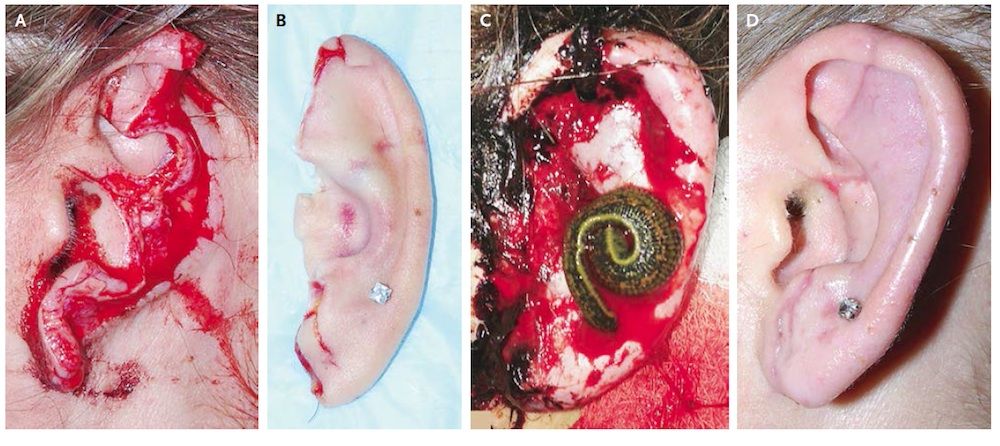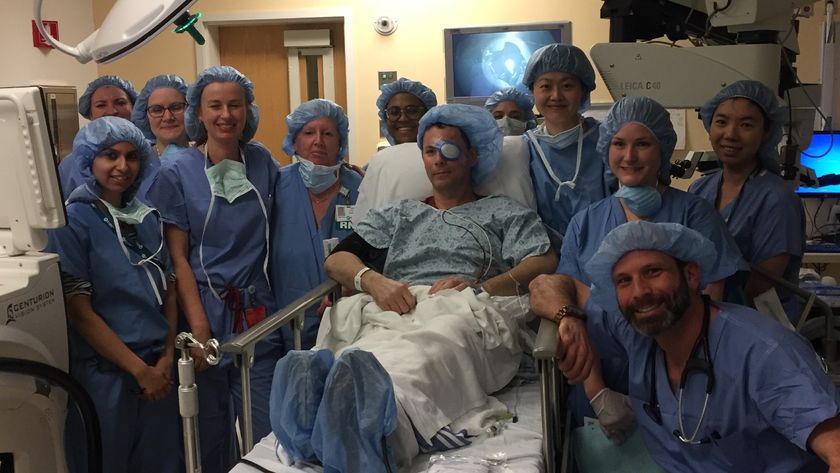Woman's Ear Reattached with Help of Leeches

A 19-year-old woman who lost her ear to a dog attack got it back with the help of a few leeches.
A pit bull mauling left the 19-year-old with a small laceration on her arm and her left ear entirely torn off, with a stud earring still in place. While plastic surgeons are trained to reattach severed organs, these reattachments are simplest when the cut is clean and sharp — as from a kitchen knife, Dr. Stephen Sullivan, a plastic surgeon at Rhode Island Hospital in Providence who operated on the young woman, told Live Science.
This woman's ear, however, was torn, making the surgery more challenging. Using a microscope and extremely delicate tools, Sullivan and his surgical team found a tiny artery only 0.3 millimeters in diameter and reattached the vessel to the woman's blood supply with three microscopic stiches.
Bring on the leeches
The artery brought fresh blood to the woman's reattached ear, but the surgical team couldn't find a vein to drain blood back to the body. So they turned to another technique: leeches.
In 2004, the Food and Drug Administration (FDA) approved these blood-sucking worms for use in medicine. [5 Wacky Things That Are Good for Your Health]
"The body is very efficient at making new arteries and veins, so the leeches are temporary," Sullivan said. "They act as temporary drainage for the ear while the ear makes its own new veins."
Sign up for the Live Science daily newsletter now
Get the world’s most fascinating discoveries delivered straight to your inbox.
For more than two weeks, the woman recovered in the hospital with leeches attached to her left ear, draining away deoxygenated blood. At first, a leech treatment often alarms patients, Sullivan said, but they often grow to respect the little bloodsuckers for what they can do.
"Nature has worked for a long, long time to make a leech, and we do not have something we've invented as scientists, engineers or doctors that has done better than what nature has done," Sullivan said.
Reattachment and recovery
Over time, the nursing staff weaned the patient off the leeches by waiting longer and longer periods between replacements. Meanwhile, the ear grew its own veins to drain the reattached tissue. Today, the scar is barely visible. Because the attack affected only the patient's outer ear, or pinna, the injuries did not damage her hearing.
Ear reattachment is challenging because of the tiny veins and arteries that feed the area, Sullivan said. Only about 50 successful procedures have been reported in the literature worldwide. Although the surgery was not a matter of life and death for this patient, it will play a major role in her quality of life, Sullivan said.
"Every time she puts her hair back in a ponytail, she is going to do it without even pausing," he said. "You see her now, and you would never know that has happened to her."
The case is reported in the April 17 issue of the New England Journal of Medicine.
Follow Stephanie Pappas on Twitter and Google+. Follow us @livescience, Facebook & Google+. Original article on Live Science.

Stephanie Pappas is a contributing writer for Live Science, covering topics ranging from geoscience to archaeology to the human brain and behavior. She was previously a senior writer for Live Science but is now a freelancer based in Denver, Colorado, and regularly contributes to Scientific American and The Monitor, the monthly magazine of the American Psychological Association. Stephanie received a bachelor's degree in psychology from the University of South Carolina and a graduate certificate in science communication from the University of California, Santa Cruz.











